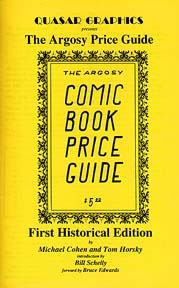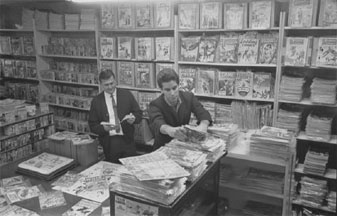
Back in the early 60’s when I was a teenager, my friend Tom Horsky and I used to bike and bus all over Los Angeles looking for old comics in bookstores. One day we chanced upon the legendary Cherokee Bookstore on Hollywood Blvd. and before we knew it we were working for Burt Blum, the King of Comics. How this event turned into our being the co-authors of the first ever comic book price guide is recounted below, in an excerpt from The Argosy Price Guide – first historical edition published by Quasar Graphics. By the way, the original guide has been known to sell for as much as $200.00! Yow!
–Michael Cohen
More about the guide is recounted in the 2nd edition of Bill Schelly’s Eisner nominated book “The Golden Age of Comic Fandom” from Hamster Press.
The Argosy Adventure as recalled by Thomas N. Horsky

Thirty years ago, Summer 1965, my best friend Michael Cohen and I started working for a small used book store off Hollywood Blvd. in downtown Hollywood, CA. The beat couple in their late 30’s who owned Argosy Books were not doing too well. They decided they needed an edge, a draw to attract business to their modest store.
At that time, used book stores dotted the streets of old Hollywood and Los Angeles proper, and many of them offered boxes of second-hand comics for a nickel, or five for 20 cents, and Mike and I would spend our summers biking from one store to another, checking out the newsstands along the route for the latest issues.
It was in this way we discovered and worked for Cherokee Books in 1962, and later Collector’s Books, both a stone’s throw from Argosy. You see, Bert Blum’s dad operated Cherokee, one of the best new and rare book store’s in LA, and had given Bert a pair of small rooms upstairs (previously used for storage) so he could pursue his hobby– buying and selling comic books.Bert opened up the world of pre-60’s comicdom to us, and hundreds of extinct 40’s and 50’s titles which we had never seen could be found on his shelves.
Our job was, and I kid you not, to sort through his recently acquired collections to determine which were valuable enough to add to the shelves (we had first pick of both the rejects and the valuables)– of course we were paid in comics. But the most exciting moment was when we were invited to delve into the cabinet which contained the golden age collectibles that fetched $2.50 and up. Of the few hundred books contained therein at any given time were the Kirby Captain America’s, Green Lantern, All-Star, Detective, Action, and in general all the original superhero mags which we had only heard of in faint whispers. The most expensive issues (well beyond the buying power of twelve-year-olds) were Action #1 at $35, Detective #27 at $25, and an exceptionally well-preserved Whiz #1 at $50. These we were allowed to read and handle as part of our education.
Being realistic investors, we nevertheless preferred rounding out our 50’s and 60’s collections with purchases such as Amazing Fantasy #15, which I bought for 35 cents, although we would occasionally part with the price of a Cap or a More Fun.Not long after, Leonard Brown and Malcolm Willits opened Collector’s Books, trying to compete with Cherokee (which they never successfully did; Bert never made much money either, but he had free rent). Len and Mal were different in that they were collectors themselves, and had a huge warehouse full of old newspapers and magazines. Hence, our work for them centered on sorting old Sunday funnies and papers (Flash Gordon was my favorite).
Mal, a schoolteacher, had an enormous private collection of the 30’s Disney books drawn by Carl Barks. I admit that I never saw half of all the stuff Collector’s had. Years later, Mal bought Cherokee Books becoming very successful as a commercial book dealer.
Back to Argosy. The owner knew that we were avid comic collectors, and he wanted to break in on the comic market, which by 1965 was beginning to look more interesting than the sagging rare book market. But Argosy had neither comic books nor any idea what they could bring. So he commissioned Mike and me to draft a price guide, ostensibly for his own use. Faced with an opportunity to make some real money from a project that sounded like fun, we agreed to charge an hourly rate for our contract services.
Upon closer scrutiny, however, the project was more difficult than it sounded, for unlike rare book appraisals, comic price guides didn’t exist. In fact, formal pricing didn’t exist. There was so little trading in golden age comics and almost no store-mediated trading in the 50’s and 60’s comics that, apart from the really visible first issues, pricing was essentially uniform: old comics were either curiosities (worth 25 cents), or collectibles (worth $2.50 to $7.00) with nothing in between. The choice we made then was to allow pricing to vary more continuously between these extremes using the same metric so long applied to books– rarity.
Due to the paper drives of WWII, many golden age comics were rare compared to their initial print runs, but not according to rare book standards. Thus, a few thousand copies in existence would render the issue valueless, a few hundreds interesting, a few tens valuable, and an issue with a few known copies, priceless. Priceless? Say– $100, but only if it was really neat. Besides, who really knew how many copies of an issue were out there? This was a decade before the discovery of the Church collection, and the only known stores on the West coast were walking distance from Bert and his cabinet.
And what about condition? Again, one could only fall back to rare book standards, and the vernacular of rare stamps and coins. Better leave that to others. Besides, if the comic had an unbroken spine and no obvious defects, it was in great condition; otherwise it was either good or trashed. Coverless comics had no value; we knew this because Bert gave away all coverless mags for free (I still have coverless issues of Captain America #1, Batman #1, Detective #28, and others rescued from the trash). Thus, condition was left out of the guide.
Once the seriousness of the project had been discussed with Argosy, they backed off from a “serious” effort and gave us instructions to put together something– the cost of which would not exceed $25, or about ten hours work. That, in its rather abridged and admittedly subjective form, became the “Argosy Comics Price Guide” the first of its kind. It was later sold through the mail with no credits given to its authors.
Tom Horsky July 3, 1995